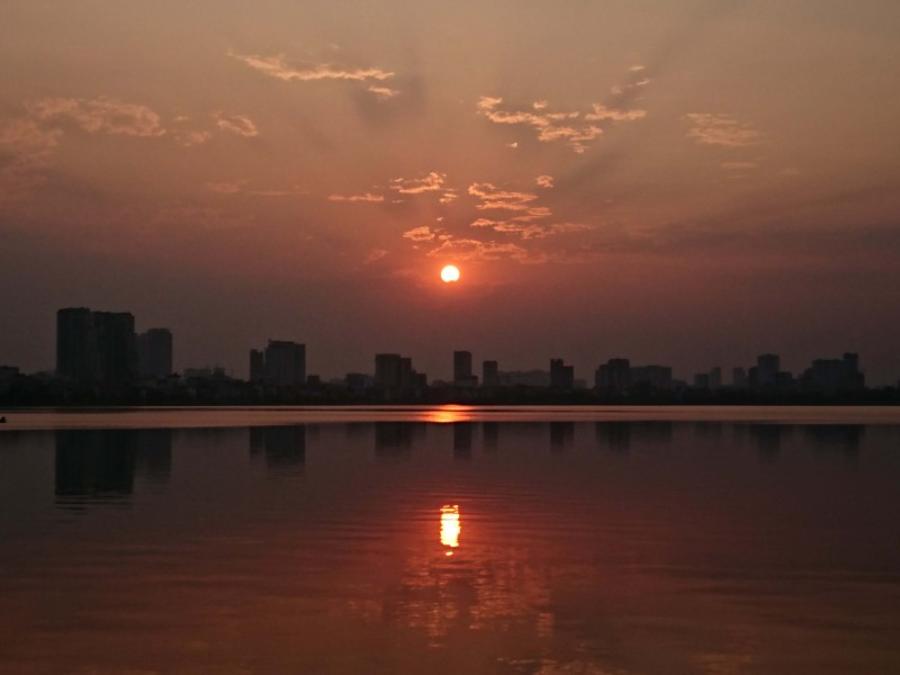Best Selling Products
Creative Tips for Taking Beautiful and Inspiring Photos of the Sun
Nội dung
- 1.Introduction to Solar Photography
- 2. Beautiful and Impressive Sun Photography Ideas
- 2.1. Shooting Sunrise and Sunset
- 2.2 Photographing the Sun Through Clouds
- 2.3. Taking Photos of the Sun When Blocked by Objects
- 2.4. Photographing the Sun with Striped Rays
- 2.5. Long Exposure Photography of the Sun
- 2.6. Photographing the Sun in an Urban Environment
- 3. Some tips for taking great photos for beginners
- 3.1 Using Silhouette Technique
- 3.2 Take Advantage of Natural Elements
- 3.3 Using Filter
- 3.4 Be Creative With Your Shooting Angle
- 3.5 Exploiting the Flare Effect
- 3.6 Pay Attention to Post-Production
- 3.7 Expressing Emotions Through Photos
- 4. Conclusion
Explore unique and creative ideas for taking photos of the sun. From sunset to sunrise, creative angles will help you capture nature's magical moments.

Sun photography is one of the most popular fields of photography because of its magical beauty and the strong emotions it brings. However, to get sparkling and inspiring photos of the sun, you need to know how to exploit light, shooting angle as well as creativity in expression. Below, sadesign lists some ideas and professional tips to help you improve your sun photography skills.
1.Introduction to Solar Photography
Sun photography is one of the most fascinating subjects for those who are passionate about nature photography. The sun is not only the only source of light but also a symbol of life, energy and eternal beauty of the universe. With the transformation of light and sky at different times of the day, the sun gives photographers countless opportunities to be creative and capture magical moments.
.jpg)
However, photographing the sun is not simple. You need to understand how to exploit the light, choose the right angle and use editing techniques to highlight the natural beauty of the sunlight. Below, we will share some ideas and techniques for photographing the sun so that you can capture the best moments.
2. Beautiful and Impressive Sun Photography Ideas
Some beautiful and impressive ideas for taking photos of the sun for your reference are below:
2.1. Shooting Sunrise and Sunset
The golden hour is the time just after sunrise or before sunset. Dawn and dusk are ideal times to photograph the sun. The light during this time is soft, warm, and creates long shadows, which can make your photos more dramatic. This is a great time to take landscape or portrait photos with beautiful natural light.
As the sun rises or sets, the light is soft and warm. This is a great time to create artistic photos, especially when combined with natural elements such as clouds, the ocean or mountains.
Dawn: At this time of year, the sunlight is a warm orange-yellow. If you shoot from the beach or a location with a wide view, you will be able to create beautiful reflections on the water.
Sunset: At the end of the day, the sunlight turns red, pink and purple. This is the ideal time to take photos with long shadows and add depth to the image.
Alternatively, try shooting during the blue hour, the time just before sunrise or after sunset. The soft light and distinctive blue hues will create a mystical, dreamy atmosphere.
2.2 Photographing the Sun Through Clouds
One creative way to photograph the sun is through clouds. When the sun shines through clouds, the light is diffused, creating soft, mysterious rays. You can use thick or thin layers of clouds to create special lighting effects.
(1).jpg)
Thick Clouds: When the sun shines through thick clouds, you will be able to capture strong rays of light that penetrate the gaps in the clouds, creating a strong yet deep lighting effect.
Thin clouds: Thin clouds will help the sunlight become softer, creating a magical space, suitable for taking photos with gentle movements of nature.
2.3. Taking Photos of the Sun When Blocked by Objects
To create unique photos, try shooting the sun when it is blocked by objects such as trees, mountains, or buildings. This will create shadow effects, adding depth and interest to the photo.
Blocked by trees: You can choose to shoot the sun through the leaves or branches of trees to create unique shadows. This also creates a sense of mystery, especially when the sun shines through the leaves.
Blocked by Mountains: If you are in an area with a mountainous landscape, capturing the sun as it sets behind the peaks can create a dramatic, dramatic scene. You can use the shadows cast by the mountains to highlight the majesty of nature.
2.4. Photographing the Sun with Striped Rays
The lens flare technique is a fun way to add interest to your sun photos. When the sun shines directly into your camera lens, you create beautiful flares that help to accentuate your photos.
(1).jpg)
Plan your shot: To create a beautiful lens flare effect, you need to time and position your shot correctly when the sun is at the right angle.
Shoot from behind: Place the camera behind the subject and let the sun shine through details like trees, buildings, or other objects. The light will create beautiful light trails and attract the viewer's attention.
2.5. Long Exposure Photography of the Sun
Another technique for creating unique sun photos is to use long exposure. By taking photos of the sun over a long period of time, you can create smooth effects on the light rays and blur the surrounding motion.
Create a light trail effect: Long exposures will help create long trails of light from the sun as it moves across the sky. This will give the photo depth and a sense of movement.
Shooting at Sunset: At sunset, you can use long exposures to create smooth light trails, creating a soft and charming space.
2.6. Photographing the Sun in an Urban Environment
Photographing the sun doesn’t have to be done in nature, you can also look for beautiful angles of the sun in urban environments. Buildings, streets, and structures can create dramatic photos when the sun shines through them.
Street Scenes: You can capture the sun as it sets or rises over skyscrapers, creating a beautiful photo with the shadows cast by the architecture.
Combine with transportation: Photographing the sun with vehicles such as cars, motorbikes or buses can create dynamic and vibrant photos.
3. Some tips for taking great photos for beginners
To take beautiful photos, beginners should take advantage of some of the following ideas:
(1).jpg)
3.1 Using Silhouette Technique
Silhouette is a photographic technique that highlights the shape of a subject against strong sunlight. To do this, you need to place your subject in the center of the frame with the sun behind it. Adjust the camera to expose for the bright areas, creating a beautiful silhouette effect. This technique is often used when photographing people, trees, or architectural structures.
3.2 Take Advantage of Natural Elements
Use natural elements like clouds, water, or trees to accentuate the sunlight. For example, clouds can create a mesmerizing translucent effect, while water will reflect light in a magical and shimmering way. Foliage can also be used to create a unique dappled light effect.
3.3 Using Filter
A neutral density (ND) or polarizing filter is a useful tool to help you control harsh sunlight when taking photos . An ND filter reduces the amount of light entering the lens, allowing you to shoot with a larger aperture or slower shutter speed, creating a soft effect on details like water or clouds. Meanwhile, a polarizing filter helps increase contrast and reduce flare.
3.4 Be Creative With Your Shooting Angle
Don’t be afraid to experiment with different angles to create unique photos. Shoot from a low angle to highlight the majesty of the sky or try a high angle to capture the whole landscape. Also, placing the sun off-center (following the rule of thirds) will help balance out and interest your photo.
3.5 Exploiting the Flare Effect
Flare occurs when direct sunlight hits the camera lens, creating shimmering streaks of light. While many people avoid this phenomenon, if you know how to control it, you can use flare to add artistry to your photos. Try adjusting the angle of your camera so that the light just touches the lens to create a gentle but captivating effect.
3.6 Pay Attention to Post-Production
Post-production is an important step in perfecting your photo. Use editing software like Adobe Lightroom or Photoshop to adjust the brightness, contrast, and color to bring out the beauty of the sunlight. However, keep it natural and avoid over-editing.
3.7 Expressing Emotions Through Photos
A good photo is not just about the right combination of light and composition, but also about conveying emotion. Think about the story you want to tell through your photo: it could be the tranquility of a morning, the splendor of a sunset, or the mystery of a falling night.
4. Conclusion
Photographing the sun is not only about capturing a natural phenomenon, but also about expressing the photographer’s creativity and ability to use light. From the soft moments of dawn to the bright rays of dusk, every time of day offers wonderful opportunities for creativity.












































